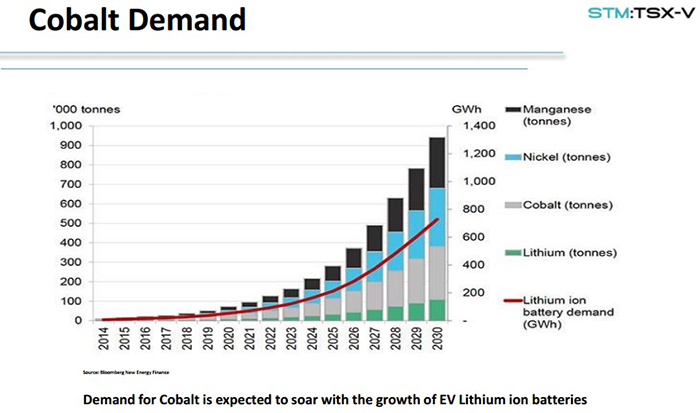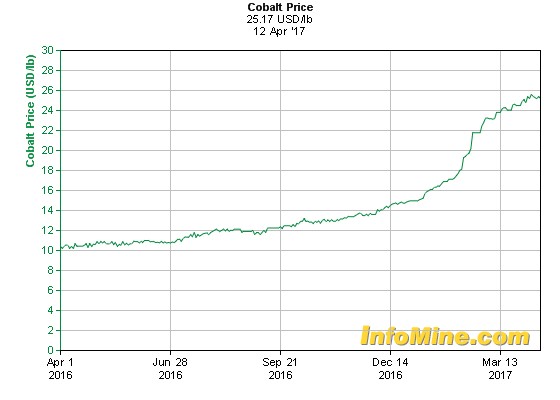Facing an acute shortage of cobalt coupled with challenging bottlenecks in the existing supply chain, ‘blue metal’ mania has taken hold.
Prices are shooting up, hedge funds are hoarding physical supplies, and buyers are wondering where the next shipments are going to come from to feed the phenomenal progression of the electric vehicle (EV) revolution and massive battery gigafactories.
First, it was lithium that shot through the roof and made millions for those who invested in it. Those who got in on lithium at the right time saw returns as high as 2,000 percent. But lithium is only one key component of the lithium-ion battery—the backbone of the latest energy revolution. Cobalt makes up some 35 percent of this mix, and it’s shaping up to be Tesla’s (NASDAQ:TSLA) bigger concern.
North America produces only about 4 percent of the world’s total cobalt supply—not enough to put a dent in the demand coming from Tesla’s new gigafactory in Nevada, which started producing batteries in January.
Now this massively overshadowed battery element is set for an explosion in demand that will blow lithium away. There simply isn’t enough. North America isn’t even on the cobalt map, and this game is definitively about finding new, ethical supply.
“Cobalt is the next big bet,” says Wayne Tisdale, a legend in the small-cap mining industry who found and financed lithium darling Pure Energy and is now CEO of Scientific Metals (TSX:STM.V; OTC:SCTFF) which is focusing on an all-American cobalt story.
In this game, the money is made by people who “look for early signs of both need and shortage in a particular commodity, find overlooked and inexpensive assets in that space, and then hire really smart people who will lead you where you need to go”, Tisdale told Oilprice.com.
So far, it’s a winning strategy. Tisdale helped launch Pure Energy (TSX:PE.V) right in Tesla’s gigafactory backyard, targeting new lithium supplies right before the lithium craze, and now he’s doing the same with cobalt.
Let the Hoarding Begin…
Global demand for cobalt is already set to exceed supply this year by 900 tonnes, and after that we’ll be looking at 20 percent demand growth year on year, in tandem with the growth of the EV industry, making cobalt the most coveted commodity on the market.
This is great for sellers, but buyers are in a panic. The battery industry is already using some 42 percent of global cobalt production, and industrial and military applications are sucking up the rest. The supply equation is already fantastically tight, without even accounting for the massive forward movement of the EV segment.
GM, Toyota and Ford have no battery manufacturing experience, and all are taking cues from Tesla and China’s BYD because they make both. Likewise, Volkswagen (VLKAY), BMW (BMW.F) and Mercedes (DDAIF) don’t produce batteries, sourcing them from Samsung (SSNLF), LG Chem (LGCLF) and Panasonic (NYSE:PC).

Tesla’s massive $50-billion market cap says all we need to know about EV growth. The company is redefining the auto industry. Tesla launched its $5-billion battery gigafactory in Nevada in January, and by the end of 2017 it will have doubled the world’s battery production capacity. This alone will result in an acute shortage of cobalt, and the small-cap explorers like Scientific Metals who may offer up new, ethical North American supply are well-positioned to take advantage of this conundrum.
Last year, EV industry production grew 41 percent. Now, sales are up more than 60 percent year on year. The EV market has grown over 15 times, with an amazing compound annual growth rate of over 72 percent from 2011-2016. This year, analysts expect it to gain another 25-26 percent.
The supply chain is in trouble if we don’t get new, ethical sources online. At least half of the world’s supply comes from the Democratic Republic of Congo (DRC), where ‘conflict minerals’ are mined. The auto industry doesn’t like to source its cobalt from here because connections to this unregulated supply chain that uses children as miners is a major reputational risk.
Tisdale—whose focus is on ethical new sources of cobalt—is ready to take full advantage of what cobalt traders called a “complete vacuum” in interviews with the Financial Times on 23 February.
February saw major cobalt acquisition initiatives by hedge funds from Switzerland to China. The hedge funds’ stockpiling of cobalt then caused a mad rush on securing new shipments, according to a 23 February Financial Times article.
Swiss-based Pala Investments and China’s Shanghai Chaos scooped up some 6,000 tonnes of cobalt and put it in storage. That’s the equivalent of 17 percent of 2016 global cobalt production, and it’s worth around $280 million at today’s prices. When they take it out of storage it is likely to be worth much more.
Until now, there hasn’t been much to choose from outside of pure cobalt companies listed in China, so hedge funds have been buying up the physical metal in a seriously bullish mentality. One trader told the Financial Times that they “decided that buying physical cobalt was the only way to get proper exposure to the cobalt price.”
This is the definitive second phase in the battery battle, and while lithium was the poster child for the first phase, now it’s all about cobalt—and speculators are betting big as prices move up ahead of a major shortage.
Since November, cobalt prices have jumped more than 50 percent, and this is only the beginning.

Source: Infomine
Cobalt’s make impressive gains for 24 straight weeks.
Tisdale’s Next Big Bet
As hedge funds start hoarding cobalt ahead of the demand surge and suppliers start panicking, Scientific Metals (TSX:STM.V; OTC:SCTFF) is stepping in to pick up the slack with a major new cobalt exploration patch. And Tisdale—who made his first mining million way back in the 1970s when he was in his 20’s—is all in. It could be his fifth consecutive home run. The last one was in lithium, and now it’s cobalt’s turn.
Tisdale and his team at Intrepid Financial have in recent years created $2.7 billion in market value by building and financing 5 companies in completely different industries.
- Rainy River (gold) was worth $1.2 billion at its peak
- Xemplar (uranium) hit $1 billion at its peak
- Ryland Oil (oil and gas) sold for $114 million
- Webtech Wireless (tech) was worth $300 million at peak
- Pure Energy (lithium) is worth $65 million (and counting)
When Tisdale helped start Pure Energy in 2012, it was another strategic move: The price of lithium was only around $5,000 per tonne, and it’s since spiked 450 percent.
And the next big thing, from Tisdale’s perspective, is Scientific Metals’ new Iron Creek project, right in the heart of the Idaho Cobalt Belt—the most prolific cobalt mineralization trend in the entire U.S.
Not only is this the only prominent region to historically mine cobalt in the U.S., it’s also home to one of the only cobalt properties slated to come into production in the next few years.
The company scooped up this project in September, along with historic resources and encouraging indications of significant potential expansion. And right next door they have the only other cobalt property in the U.S. that is slated to come into production, and it’s got an estimated 3 million-plus tons of .55 percent cobalt.
STM has a property that has already seen a substantial amount of historical exploratory work, including 30,000 feet of diamond drilling.
With some half of the world’s entire cobalt supply ethically off-limits, Scientific Metals is targeting an ethical cobalt solution in the United States. And the client list is only getting bigger, with companies like Apple (NASDAQ:AAPL), LG Chem and Samsung all under pressure to source ethical cobalt.
What it all means is that Tisdale and his team could be among the first to put the U.S. on the cobalt production map just as battery demand hits fever pitch. It’s an impressive strategic move that matches up with Tisdale’s earlier successes.
Home run No. 6 would seem to be in the making, and Scientific Metals is fully financed to make it happen. So, far, they’ve secured $3.5 million in financing, sufficient to cover this year’s exploration program.
So, what’s next? Expanding upon the work that has been done and further delineating the cobalt resource. After that, the company hopes to become the largest pure play cobalt producer in North America, advancing projects into production and selling off to a major.
As cobalt explodes, it’s not just about how much supply we have; it’s about where it comes from, and how we can make it ‘all-American’. Right now, that’s Scientific Metals—and the big bet on cobalt here is supported by some amazing fundamentals.
The cobalt craze is already upon us, and Tisdale is way ahead of it.
5 other TSX stocks worth watching in the cobalt space:
In the cobalt craze, all these companies should get a boost, but the pure plays like ECS and STM are the best bets.
- eCobalt Solutions (TSX:ECS): This company is a mining exploration and development outfit whose flagship project is in the same Idaho belt where Scientific Metals is gearing up for big things. ECS also holds properties in Canada and Mexico. Shares are up over 57% year-to-date.
- First Quantum Minerals (TSX:FM): FM isn’t just about cobalt, so this isn’t a pure play, but it’s share price is up over 24% year-to-date, and the cobalt craze should give it a bit of a boost. FM operates six mines, one of which (Ravensthorpe) is nickel and cobalt, though the cobalt produced is less than 2%.
- PolyMet Mining (TSX:POM): PolyMet owns the NorthMet copper-nickel-cobalt precious metals project, and once it’s up and running, hopes to be producing 72 million pounds of copper, 15.4 million pounds of nickel, but only 720,000 pounds of cobalt.
- Lundin Mining (TSX:LUN): The company is small, but diverse, with operations in Chile, the US, Portugal and Sweden. It’s not cobalt-focused, but it does have a 24% stake (indirectly) in the DRC Tenke Fungurume copper-cobalt mine, along with a stake in Freeport Cobalt and its Finnish cobalt refinery. Shares have gained over 22% year-to-date.
- Canada’s Ivanhoe Mines (TSX:IVN): IVN has recently said it plans to develop the DRC-based Kamoa-Kakula deposit, thought to be one of the biggest high-grade copper discoveries in the world. Cobalt will be a lucrative by-product.
Legal Disclaimer/Disclosure: This piece is an advertorial and has been paid for. This document is not and should not be construed as an offer to sell or the solicitation of an offer to purchase or subscribe for any investment. No information in this Report should be construed as individualized investment advice. A licensed financial advisor should be consulted prior to making any investment decision. We make no guarantee, representation or warranty and accept no responsibility or liability as to its accuracy or completeness. Expressions of opinion are those of Baystreet.ca only and are subject to change without notice. Baystreet.ca assumes no warranty, liability or guarantee for the current relevance, correctness or completeness of any information provided within this Report and will not be held liable for the consequence of reliance upon any opinion or statement contained herein or any omission. Furthermore, we assume no liability for any direct or indirect loss or damage or, in particular, for lost profit, which you may incur as a result of the use and existence of the information, provided within this Report.